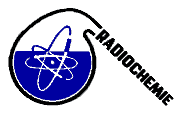Speaker
Ms
Violeta Hansen
(Radiation Research Department, Risø National Laboratory for Sustainable Energy,Technical University of Denmark- DK-4000 Roskilde, Denmark)
Description
Long physical half life, long residence time in the marine environment and continuous releases from nuclear fuel reprocessing plants make 129I a suitable tracer for the study of marine geochemical cycle of stable iodine and conversion mechanism of iodine species by speciation analysis of 129I and127I. Up to date there are few data on chemical speciation of 129I in seawater and no 129I chemical speciation analyses in seawater profile was reported. The converting mechanism of iodine chemical species is still unclear.
In the present work, depth profile samples of seawater collected from the Kattegat Belt Sea and Baltic Sea are analyzed for 129I, 127I as iodide, iodate by using anion exchange chromatography coupled with accelerator mass spectrometry (AMS), inductively coupled plasma mass spectrometry (ICP-MS) respectively.
A relatively high concentration of 129I (2-18 x 1010 atom/L) was found in the Kattegat comparing with that in the Baltic Sea (<2 x 1010 atom/L). The results show that in the Baltic Sea the concentrations of 129I, 127I increase with depth and salinity, while the same trend does not occurred in the Kattegat Basin. In Baltic Sea the predominant species of iodine is iodide while in the Kattegat the ratio 129I-/129IO3- is 1-2. Along the water profile, the atomic ratios of 129I-/127I- and 129IO3-/127IO3- decrease from the northern Kattegat to the central Baltic Sea.
Speciation analysis of 129I in seawater profile is indispensable for a better understanding of geochemical cycle of stable iodine and the converting mechanism of iodine species in the marine environment.
Author
Ms
Violeta Hansen
(Radiation Research Department, Risø National Laboratory for Sustainable Energy,Technical University of Denmark- DK-4000 Roskilde, Denmark)
Co-authors
Mr
Ala Aldahan
(Department of Earth Science, Uppsala University, SE-758 36 Uppsala, Sweden)
Mr
Goran Possnert
(Tandem Laboratory, Uppsala University, SE-751 20 Uppsala, Sweden)
Mr
Peng Yi
(Department of Earth Science, Uppsala University, SE-758 36 Uppsala, Sweden)
Mr
Per Roos
(Radiation Research Department, Risø National Laboratory for Sustainable Energy,Technical University of Denmark- DK-4000 Roskilde, Denmark)
Mr
Xiaolin Hou
(Radiation Research Department, Risø National Laboratory for Sustainable Energy,Technical University of Denmark- DK-4000 Roskilde, Denmark)

